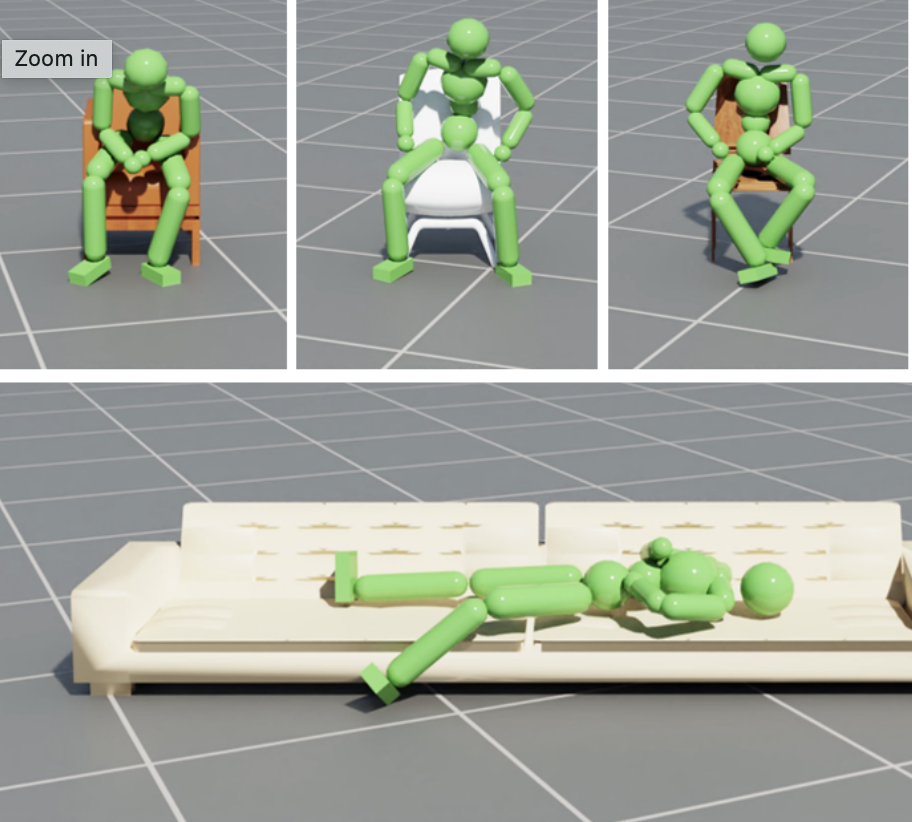
Movement is how people interact with and affect their environment. For realistic virtual character animation, it is necessary to realistically synthesize such interactions between virtual characters and their surroundings. Despite recent progress in character animation using machine learning, most systems focus on controlling an agent's movements in fairly simple and homogeneous environments, with limited interactions with other objects. Furthermore, many previous approaches that synthesize human-scene interaction require significant manual labeling of the training data. In contrast, we present a system that uses adversarial imitation learning and reinforcement learning to train physically-simulated characters that perform scene interaction tasks in a natural and life-like manner. Our method is able to learn natural scene interaction behaviors from large unstructured motion datasets, without manual annotation of the motion data. These scene interactions are learned using an adversarial discriminator that evaluates the realism of a motion within the context of a scene. The key novelty involves conditioning both the discriminator and the policy networks on scene context. We demonstrate the effectiveness of our approach through three challenging scene interaction tasks: carrying, sitting, and lying down, which require coordination of a character's movements in relation to objects in the environment. Our policies learn to seamlessly transition between different behaviors like idling, walking, and sitting. Using an efficient approach to randomize the training objects and their placements during training enables our method to generalize beyond the objects and scenarios in the training dataset, producing natural character-scene interactions despite wide variation in object shape and placement. The approach takes physics-based character motion generation a step closer to broad applicability.
| Author(s): | Hassan, Mohamed and Guo, Yunrong and Wang, Tingwu and Black, Michael J. and Fidler, Sanja and Bin Peng, Xue |
| Book Title: | ACM SIGGRAPH 2023 Conference Proceedings |
| Year: | 2023 |
| Month: | August |
| Bibtex Type: | Conference Paper (inproceedings) |
| Event Name: | SIGGRAPH 2023 |
| Event Place: | Los Angeles, USA |
| State: | Published |
| Electronic Archiving: | grant_archive |
| Links: | |
BibTex
@inproceedings{Hassan:SIG:2023,
title = {Synthesizing Physical Character-scene Interactions},
booktitle = {ACM SIGGRAPH 2023 Conference Proceedings},
abstract = {Movement is how people interact with and affect their environment. For realistic virtual character animation, it is necessary to realistically synthesize such interactions between virtual characters and their surroundings. Despite recent progress in character animation using machine learning, most systems focus on controlling an agent's movements in fairly simple and homogeneous environments, with limited interactions with other objects. Furthermore, many previous approaches that synthesize human-scene interaction require significant manual labeling of the training data. In contrast, we present a system that uses adversarial imitation learning and reinforcement learning to train physically-simulated characters that perform scene interaction tasks in a natural and life-like manner. Our method is able to learn natural scene interaction behaviors from large unstructured motion datasets, without manual annotation of the motion data. These scene interactions are learned using an adversarial discriminator that evaluates the realism of a motion within the context of a scene. The key novelty involves conditioning both the discriminator and the policy networks on scene context. We demonstrate the effectiveness of our approach through three challenging scene interaction tasks: carrying, sitting, and lying down, which require coordination of a character's movements in relation to objects in the environment. Our policies learn to seamlessly transition between different behaviors like idling, walking, and sitting. Using an efficient approach to randomize the training objects and their placements during training enables our method to generalize beyond the objects and scenarios in the training dataset, producing natural character-scene interactions despite wide variation in object shape and placement. The approach takes physics-based character motion generation a step closer to broad applicability.},
month = aug,
year = {2023},
slug = {hassan-sig-2023},
author = {Hassan, Mohamed and Guo, Yunrong and Wang, Tingwu and Black, Michael J. and Fidler, Sanja and Bin Peng, Xue},
month_numeric = {8}
}

